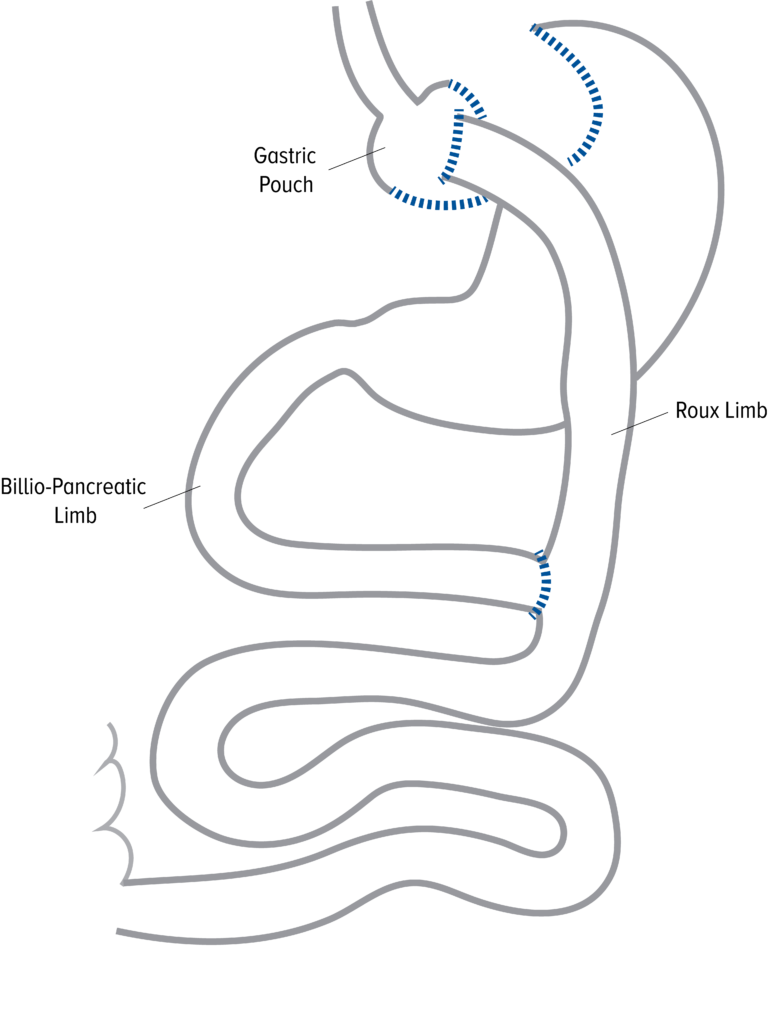Gastric Bypass
Appointment - 919-350-WELL (9355)Thinking About Bariatric Surgery? Let Us Help
Sign Up for an Information Session
Sign UpGet Started on the Path to Weight Loss
Get Started
Gastric Bypass
Roux-en-Y gastric bypass was first performed over 50 years ago and is still considered the gold standard for bariatric surgery today. This surgery limits the amount of food you can eat by creating a small stomach and changes the digestive tract by bypassing the remainder of the stomach and first part of the small intestines.
The food then passes out of the pouch through a small opening into the small intestine. Most of the stomach and the first part of the small intestine are bypassed by the food. (If the gallbladder is diseased, it may be removed during the operation.)
Patients lose weight by eating smaller meals and having less hunger.
Highlights
- Longest track record of all bariatric procedures
- Excellent control of and even cure diabetes
- Greatest control of heart burn, reflux or gastroesophageal reflux disease
- Most often included in bariatric benefits by all insurance companies
- Risk of dumping syndrome helps patients avoid sugar and fat intake
What to Expect
Patients come to the hospital the day of surgery and are put to sleep by anesthesia. Through a laparoscopic approach, the surgeon staples across the stomach, creating a pouch about the size of an egg and then bypassing 25 percent of the small intestines. The new stomach pouch limits the amount of food patients can consume in one sitting. In bypassing a portion of the intestines, we also limit the time food can mix with digestive juices.
The operation is usually done with laparoscopic instruments through several small incisions, using specialized instruments.
If for whatever reason, the operation cannot be safely completed using the small incisions, the abdomen will be opened, and the operation will be completed as an open procedure. You may have an open procedure (or your surgeon may switch during the procedure from laparoscopic to open) if:
- Prior abdominal surgery has caused dense scar tissue.
- The surgeon is unable to see organs.
- There are bleeding problems during the operation.
The entire gastric bypass procedure usually takes about an hour and a half. Most patients go home in a day or two, once they are walking, breathing and drinking appropriately. Return to work varies between a week and a month based on the physical requirements of the patient’s job. A few more vitamins are required after surgery compared to a sleeve gastrectomy because of the smaller pouch and the bypassing of some of the small intestine.
Results
Patients can expect to lose about 60 to 75 percent of their excess weight within the first year after surgery. Patients can also expect resolution or improvement of medical conditions such as hypertension and diabetes, often within the first few weeks or months after surgery. Results vary by patient.
Disadvantages
- Risk of ulcer disease, particularly with tobacco users
- Reduced absorption of some nutrients. Patients must supplement their diet with a daily multivitamin, calcium, vitamin B12 and iron.
- Unpleasant dumping syndrome may occur with fat or sugar intake. While it isn't considered a health risk, the results can be unpleasant and may include vomiting, nausea, weakness, sweating, faintness, and diarrhea.
Potential Concerns
In addition to standard surgical risks, concerns to be aware of include:
- Nausea and vomiting
- Leaks from staple line
- Small bowel obstruction
- Nutritional deficiencies
- Mortality rate: 0.1 percent
Risks specific to the gastric bypass include leaks at the staple lines and new connections created during the procedure. A leak could mean an extra few days in the hospital, additional antibiotics or another laparoscopic procedure. Long term risks include an ulcer at the connection between the pouch and the intestine as well as bowel obstructions and internal hernias.
This Surgery May Not Be Right for You
If you have these conditions, this surgery may not be right for you:
- You have had a malignancy within the last five years.
- You have any of the medical conditions that would make an operation too risky.
- You have had extensive abdominal surgery.
What to Expect After Surgery
A hospital stay after a gastric bypass procedure is typically 24 to 48 hours. Many patients return to normal activity within one to two weeks. Heavy lifting is restricted for about four weeks.